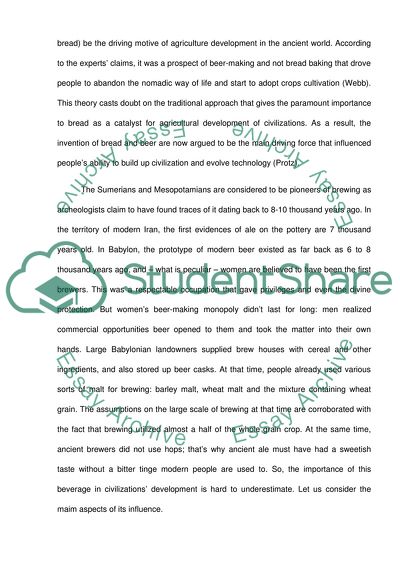Cite this document
(Beer and Mind-Altering Substances in Religion Essay Example | Topics and Well Written Essays - 2000 words, n.d.)
Beer and Mind-Altering Substances in Religion Essay Example | Topics and Well Written Essays - 2000 words. https://studentshare.org/history/1833386-why-do-you-think-beer-making-and-the-use-of-mind-altering-substances-developed-so-early-in-human-history-explore-the-religious-political-and-cultural-implications-of-the-use-of-these-substances-on-ancient-civilizations
Beer and Mind-Altering Substances in Religion Essay Example | Topics and Well Written Essays - 2000 words. https://studentshare.org/history/1833386-why-do-you-think-beer-making-and-the-use-of-mind-altering-substances-developed-so-early-in-human-history-explore-the-religious-political-and-cultural-implications-of-the-use-of-these-substances-on-ancient-civilizations
(Beer and Mind-Altering Substances in Religion Essay Example | Topics and Well Written Essays - 2000 Words)
Beer and Mind-Altering Substances in Religion Essay Example | Topics and Well Written Essays - 2000 Words. https://studentshare.org/history/1833386-why-do-you-think-beer-making-and-the-use-of-mind-altering-substances-developed-so-early-in-human-history-explore-the-religious-political-and-cultural-implications-of-the-use-of-these-substances-on-ancient-civilizations.
Beer and Mind-Altering Substances in Religion Essay Example | Topics and Well Written Essays - 2000 Words. https://studentshare.org/history/1833386-why-do-you-think-beer-making-and-the-use-of-mind-altering-substances-developed-so-early-in-human-history-explore-the-religious-political-and-cultural-implications-of-the-use-of-these-substances-on-ancient-civilizations.
“Beer and Mind-Altering Substances in Religion Essay Example | Topics and Well Written Essays - 2000 Words”. https://studentshare.org/history/1833386-why-do-you-think-beer-making-and-the-use-of-mind-altering-substances-developed-so-early-in-human-history-explore-the-religious-political-and-cultural-implications-of-the-use-of-these-substances-on-ancient-civilizations.


